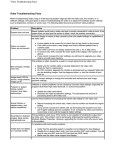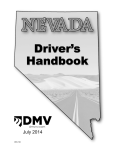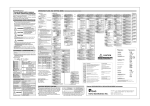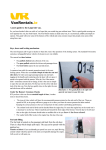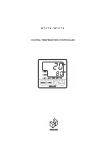Download Transport Inspectors and vehicle safety factsheet
Transcript
Check your vehicle and stay safe Road trips are great family fun and a wonderful way to explore Queensland. The Department of Transport and Main Roads wants you to arrive safely at your destination and urges you to conduct a vehicle safety check before leaving on any road trip. What to look out for Our Transport Inspectors suggest checking your vehicle two weeks before your trip so any defects can be repaired in time. Below are some tips that could help you avoid breakdowns and save you in the long run. Please note - vehicle safety checks do not replace a mechanical service and should be part of your regular vehicle maintenance. Under the vehicle visual inspection (without getting your hands dirty) • L ook in your vehicle owner’s manual for tips on vehicle maintenance and what should be checked. • Is the exhaust or muffler leaking? • Look under the body of the vehicle – are any wires or materials loose or hanging? • Check the oil level and top up if necessary. Only use the grade of oil recommended by the vehicle manufacturer. If the oil is darker than usual, it may contain contaminants which indicate that a service is due. Cloudy oil may indicate a water leak. Under the bonnet • L ook in your vehicle owner’s manual for tips on vehicle maintenance and what should be checked. • M ake sure you top up with the correct fluids to the right level and don’t overfill or spill. A Transport Inspector conducting a safety check. • R emove any corrosion on your battery terminals or cables with sandpaper, a steel brush or small amount of warm water. Tighten battery cables if necessary and top up your battery if needed with battery electrolyte fluid or boiled water which has cooled to room temperature. Glass • C heck the brake or clutch, power steering and engine coolant levels against the minimum and maximum indicators as marked on the reservoirs and top up if necessary. Check your owner’s manual for the correct fluids as there are many different types. Never open the engine coolant reservoir while the engine is hot. • E nsure there are no cracks or chips on the other windows and that any window tints are free of bubbles, scratches or marks that affect vision. • E nsure there is sufficient fluid in the reservoir. A cheap, effective solution is to make a mixture of water and household glass cleaner (25 percent glass cleaner fluid). Tyres and wheels • Check the front tyres by turning the steering wheel to full lock on both the left and right hand sides. • Check for abnormal wear on both front and rear tyres. The tread must be at least 1.5mm deep relating to the surface that contacts the road. The spare should also have sufficient tread. • Check that nothing is stuck in the tyres (glass or nails) and make sure there are no holes, puncture marks or cracks on your tyres. If in doubt, have it checked by a qualified mechanic or a tyre fitter. • Check the tyre pressure on all tyres, including the spare, ‘cold’ or after limited driving. Most cars have a sticker or tyre placard in one of the front door wells or glovebox that indicate the recommended tyre pressure. If you can’t find it, check your owner’s manual. • Ensure there are no cracks or chips in the windscreen that affect the driver’s vision. On a bumpy road, small cracks or chips can become large very quickly. Lights and electrical • L ights can be checked by having another person assist or position the vehicle so rear lights may be seen off a reflective surface. Check the headlights including high beam, park lights and tail lights, front, back and side indicators, reversing lights, brake lights and horn. • M ake sure light covers are clean. Replace light covers that are faded or damaged in any way. Take a test drive Take a test drive and pay attention to the sound and feel of your car. • Does the engine sound okay? Are there any unusual noises, ticking or clunking sounds? • Is your steering wheel stable on straight roads and turns? • Do the accelerator, brake and clutch respond normally and effectively? • Keep an eye on the temperature gauge, does it rise quickly or unexpectedly? Defective vehicles Driving a defective vehicle can endanger you, your family and other drivers. You may also receive a fine and loss of demerit points. Every driver is responsible for ensuring their vehicle is free from defects before driving on a road. If a defective vehicle is involved in a crash, a person may face criminal charges or have their insurance declared void at the time of the crash.




